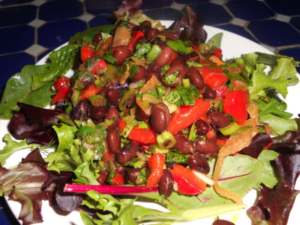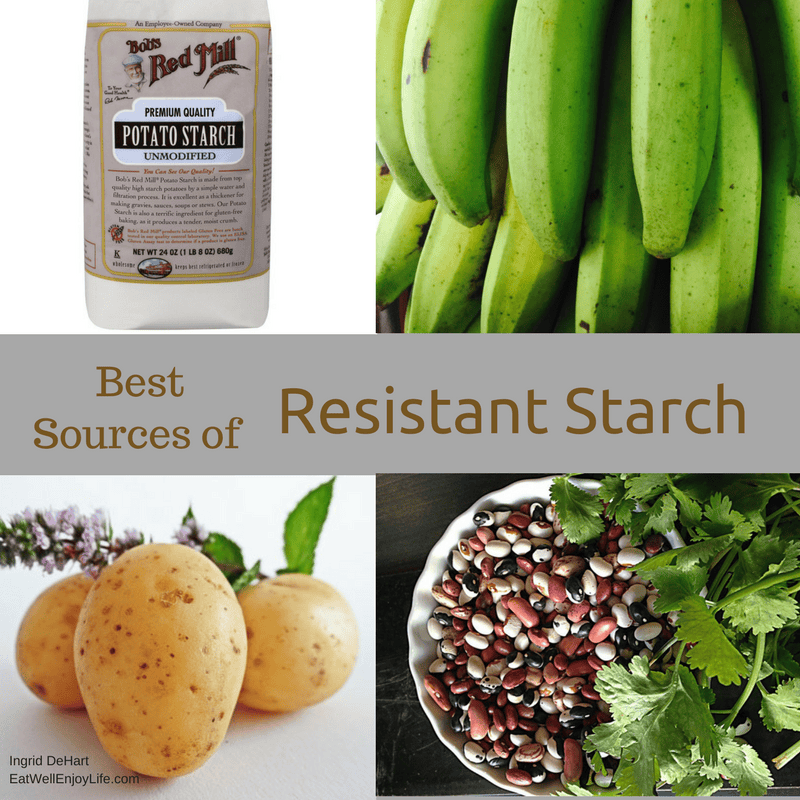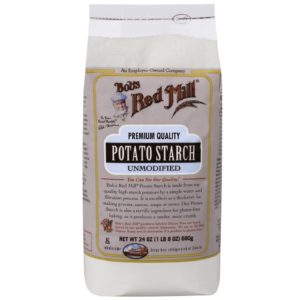There is quite a bit of information out there about reducing your carbs for better health. Sometimes I think we’re all afraid of starches. Yes there are starchy foods full of simple carbs that spike your blood sugar and insulin and don’t offer much fiber. You know what I’m talking about breads, pastas, cookies with white flour and white sugar. All the experts agree limiting these kinds of starches is beneficial for your health.
But did you know there is one type of starch that is good for you? It’s called resistant starch. This starch actually makes you lean and healthy.
Resistant starch has the unique ability to improve your metabolism and blood sugar
by optimizing your gut bacteria.
It’s called resistant starch because it’s a type of starch that’s not digested in the small intestine.
It “resists” digestion and does not spike blood sugar or insulin.
Instead it moves down into the large intestine and actually feeds the good bacteria there. These bugs produce short-chain fatty acids which provide your colon cells fuel.
The way it works is your large intestine and the bacteria within it need a fuel called butyrate in order to thrive. Butyrate is a type of fatty acid that helps your gut work right. It also has powerful anti-inflammatory effects that go beyond the gut.
To make butyrate the large intestine needs starch. Unlike most starch that is broken down in the small intestine, resistant starch reaches the large intestine (colon) intact. As the resistant starch enters your colon the good bacteria “feed” on and digest or ferment the starch and produce short chain fatty acids, especially butyrate.
Butyrate is highly beneficial to the immune system and reduces overall inflammation. (1) (2). It can help prevent cancer and speed up your metabolism. Making butyrate provides colon cells fuel that heals your gut and prevents leaky gut that drives food allergies, inflammation and weight gain.
Essentially, resistant starch is a prebiotic. Consider it to be compost or “fertilizer” for your healthy gut bacteria which is important for every part of your health. In order to keep your microbiome (inner garden) thriving it’s good to give your gut bacteria the prebiotics they love to munch on. By increasing the good bacteria, you crowd out bad bacteria, thereby reducing inflammation and improving your overall health.
Health Benefits of Resistant Starch
For over three decades, there have been studies looking at the health benefits of resistant starch in humans and animals. The results are remarkable. Resistant starch has been shown to:
- Decrease inflammation in the gut and other tissues (4) (5)
- Improve immunity
- Healthier microbiome, particularly increasing bifidobacterium
- Lower blood glucose levels
- Improve insulin sensitivity
- Help with weight loss (3)
- Decrease appetite, increase satiety
- Decrease fat storage in fat cells
- Increase absorption of minerals like calcium and magnesium (6)
Fantastic right?
Best Sources of Resistant Starch
Cooked and Cooled Potatoes

One of the best foods sources of resistant starch is cooking and cooling potatoes or rice and not reheating them. This process changes starches and how your body digests them, decreasing insulin spikes and feeds good bacteria. A 200 gram potato has about 9 grams of resistant starch.
Recipe: Kale and Romaine Caesar Salad with Potato “Croutons”
Green Bananas

Ripe bananas as you probably know contain a lot of sugar. However, when a banana is unripe, it contains a high amount of resistant starch and a low amount of sugar. The resistant starch is converted to sugar as it ripens.
Add ½-1 green banana to any smoothie. Keep them in the refrigerator and they’ll stay green longer. You can peel, slice and freeze them to use as needed in smoothies. 1 green banana has about 34 grams of resistant starch
Recipe: Strawberry Breakfast Smoothie
Potato Starch
Bob’s Red Mill Unmodified Potato Starch (DON’T USE POTATO FLOUR) is one of the best sources of resistant starch. It contains about eight grams of resistant starch per tablespoon. This starch doesn’t affect blood sugar levels, as your body doesn’t digest it. Your gut bacteria does. Don’t cook it, keep it raw.
Beans

Black beans, red lentils, and navy beans have moderate amounts of resistant starch.
Recipe: Southwestern Black Bean Salad
START SLOWLY
Studies show that 15-30 grams of resistant starch daily is best. That amounts to about two to four tablespoons of potato starch or 1/2 – 1 green banana.
Don’t overload your system with resistant starch right away.
Start slowly to allow your system to get use to it. Resistant starch can change the bugs in your gut and cause gas, known as the die-off affect. Once the good bugs get strong, they duke it out with the bad bugs. As a result, you may experience gas and bloating. As the good bugs crowd out the bad ones, the die-off will lessen and eventually completely go away.
Some increased gas and bloating is expected as your gut flora changes and adapts, but you do not want to feel uncomfortable. If you experience too much discomfort, then decrease the amount you’re taking for a few days until your symptoms get better, and then increase again gradually.
If you use the potato starch. Start with 1 teaspoon in the morning and 1 teaspoon in the evening, and very gradually increase the amount.
Many people who consistently include resistant starch in their diet experience improvements in their bowel movements, better digestion, blood sugar control, better muscle tone, weight loss, great sleep and beautiful dreams. Doesn’t’ that sound fantastic! Give it a try and let me know how it works for you.









Thank you!
Red mill potato starch themselves say it is not a good source of resistant starch, because it is heated in the drying process.
I just bought it 🙄
So I sm confused, is it or is it not?
Kind regards,
Maaike
Hi Maaike,
Thank you for asking this question. Acccording to Dr Mark Hyman, it is a resistant starch. You can read about it here. https://drhyman.com/blog/2016/03/24/the-starch-that-makes-you-lean-and-healthy/#:~:text=Bob's%20Red%20Mill%20Unmodified%20Potato,of%20resistant%20starch%20per%20tablespoon.